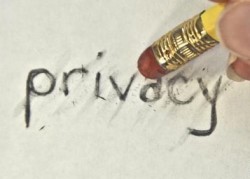This era of big data and big exposure – of all aspects of life to peers, the public and even perpetrators – calls for big participation. Because every day people are exposing, sharing, uploading, creating and inputting things about themselves and others, whether in social situations or part of their jobs, as friends, relatives, students or professionals, everybody is a participant (and stakeholder) in protecting their own and one another’s privacy. Certainly that includes school, corporations and government entities too.
 Just in the area of student privacy, we’ve certainly seen unprecedented participation on parents’ part, first with the demise last spring of InBloom, which was a nonprofit student data management organization aimed at improving public education (the Wall Street Journal reported on this). Concerns about our kids socializing in a fishbowl are justifiably spreading to fear that they’ll have to learn in one too. Commenting in the New York Times, Olga Garcia-Kaplan, a parent and student privacy advocate who blogs for FERPAsherpa.org, summed it up beautifully with: “Don’t our students have the right to learn imperfectly, and with the privacy for trial and error?”
Just in the area of student privacy, we’ve certainly seen unprecedented participation on parents’ part, first with the demise last spring of InBloom, which was a nonprofit student data management organization aimed at improving public education (the Wall Street Journal reported on this). Concerns about our kids socializing in a fishbowl are justifiably spreading to fear that they’ll have to learn in one too. Commenting in the New York Times, Olga Garcia-Kaplan, a parent and student privacy advocate who blogs for FERPAsherpa.org, summed it up beautifully with: “Don’t our students have the right to learn imperfectly, and with the privacy for trial and error?”
Since the InBloom implosion, state legislatures have passed more than 20 student privacy laws so far and introduced 110 bills, EdSurge reported last month, and federal legislation that would update FERPA (the Federal Educational Rights & Privacy Act) was introduced in July, Education Week reported. And ed tech companies seem to be stepping up, signing a pledge to protect student privacy (see Education Week).
Now students are stepping up
Art. VI on “Information and Privacy” of this student-developed Student Bill of Rights describes “the right to control and access one’s information” this way: “All students are protected from arbitrary interference or constraint of their privacy, regardless of circumstance, whether in person, online or within school. A school may not share student records without the prior written consent of the student or their legal guardian. The handling of student information must be a transparent process and the responsible institution must be accessible.” [The Student Bill of Rights, a growing crowd-sourced work in progress, is a project of Student Voice (think of the potential for school climate improvement of schools officially recognizing a student-sourced bill of students’ rights).]
Transparency goes hand-in-hand with participation or agency, the capacity to act. Without the latter, we and our children are helpless in the face of all this transparency. And without transparency, we have nothing to act on. For their own privacy, safety and wellbeing, we must encourage and enable youth to act on their own behalf, with the literacy skills of this very social digital media environment (media, digital and social literacy).
And any action for students on adults’ part – whether by lawmakers, education officials or corporations (and I hope parents) – needs to involve students’ views and participation. That’s Art. V of the Student Bill of Rights. It’s also enshrined in the UN Convention on the Rights of the Child, ratified by 194 countries. [The New York City Department of Education based its development of a social media guide for students on that principle.] As for privacy…
“Empowering students to have a larger role in deciding what ought to be included in their educational records would improve the value of the information: students would be invested in their data — as some are with grades, for example — and not merely passive participants, harboring concerns about their privacy,” wrote Garcia-Kaplan in her commentary for the Times.
Related links
- Fourteen companies – including Microsoft, educational publisher Houghton Mifflin Harcourt, digital curriculum developer Amplify and school “social learning network” Edmodo – have pledged to protect the privacy of K-12 students. The pledge, developed by the Future of Privacy Forum, includes promises not to sell students’ information, not to use their data to target them with ads and “not to compile personal profiles of students unless authorized by schools or parents,” the New York Times reports. [See what else they’ve promised here.]
- “From ‘Big Data’ to ‘Big Parent’: Student privacy developments” (July 2014)
- “A task force report & a student bill of rights” (June 2014)
- “Proposed ‘rightful’ framework for Internet safety” (July 2014)
- “Our kids’ privacy & a White House report on ‘big data'” (May 2014)
- “Facebook privacy & the social media ‘collective unconscious'”

Leave a Reply